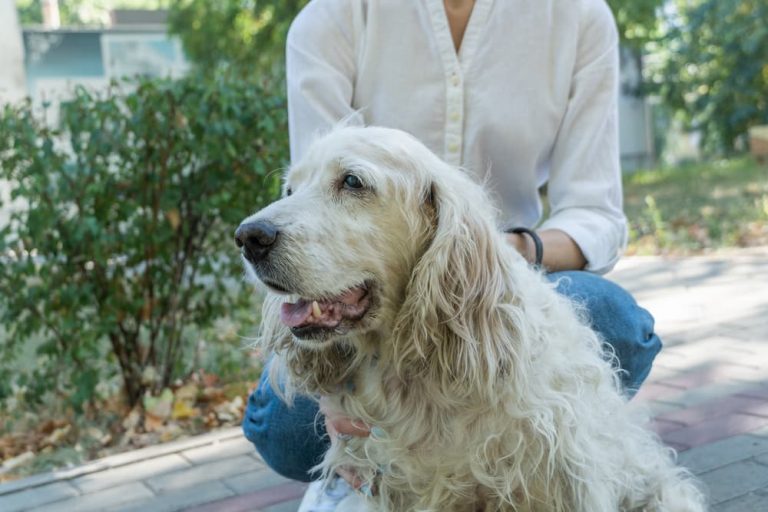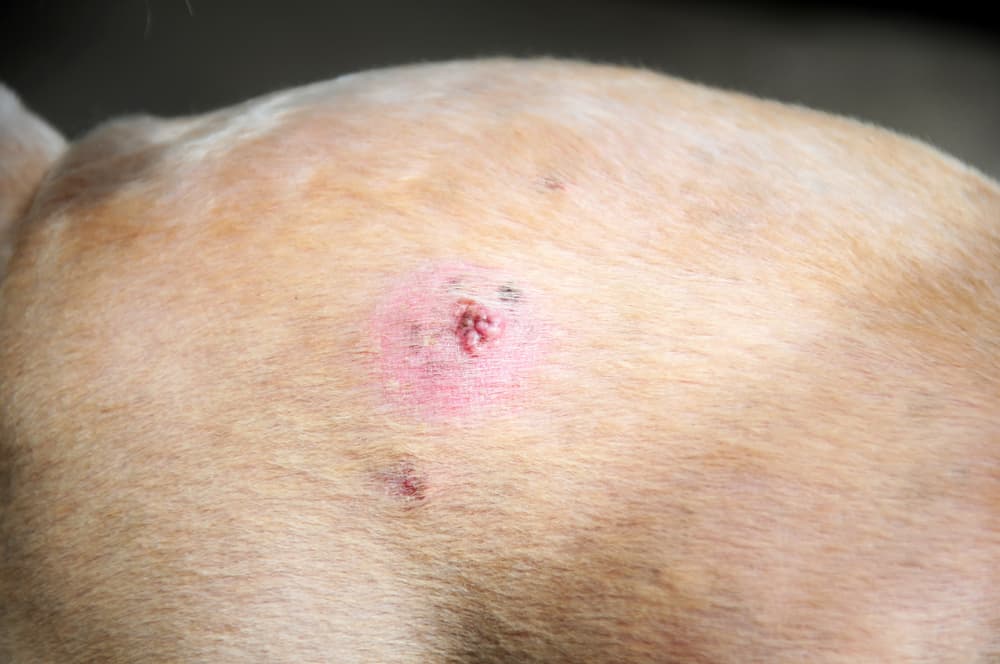Dog Skin Cancer: Types, Signs, and Treatment

Overview
If you find a lump or bump on your dog’s skin, it’s easy to become worried and concerned. Pet parents may immediately suspect a case of dog skin cancer and expect the worst. But, while it’s true that some lumps and tumors can develop into aggressive diseases, others don’t cause major problems. In fact, it’s estimated that 60-80 percent of skin tumors in dogs are benign.
Determining whether your dog has skin cancer or a benign tumor, requires taking your pet to a veterinary clinic for an examination.
Let’s set the record straight on types of dog skin cancer, treatment options, and what to expect if your dog does get a skin cancer diagnosis.
Can Dogs Get Skin Cancer?
Like humans, dogs can get skin cancer. But while the leading cause of skin cancer in humans is overexposure to ultraviolet rays in the sun, dogs are more likely to get skin cancer due to age or genetics, says Dr. Stephanie Sheen, a veterinarian at the online pet healthcare service Fuzzy.
“Older dogs are more likely to have tumors develop because their cell repair mechanisms are less robust,” Dr. Sheen says.
Besides age, a dog’s breed can determine whether or not a dog gets skin cancer. For instance, breeds like Boxers, Labrador Retrievers, Golden Retrievers, Cocker Spaniels, and German Shepherds can be particularly susceptible to some types of skin cancer.
However, just about any dog — of any age — can get skin cancer, so it’s essential to look out for warning signs and symptoms and keep up with your dog’s routine veterinary exams.
What Does Skin Cancer on Dogs Look Like?

Dog skin cancer tends to manifest in lumps, bumps, and bulges. You can spot some visually, but you should also give your dog regular at-home examinations. This includes feeling around your dog’s body for anything unusual. Doing this is particularly important for dogs with a lot of fur since fur can easily hide bumps. If you notice anything unusual, contact your veterinarian immediately.
“In general, a rule of thumb is that any lump bigger than a pea and/or present for more than one month should be examined by a veterinarian and tested,” says Dr. Sheen.
Another telltale sign of skin cancer is any change to skin pigmentation, such as red and raised circular bumps or blood blisters. If you notice a discharge coming out of a lump or bump, it should be examined by a veterinarian as soon as possible.
“Almost always, testing is necessary to determine the type of cells responsible for the growth,” says Dr. Sheen. “But if a mass is growing or spreading rapidly, becomes ulcerated, or has discharge present like blood or pus, that may indicate it is more aggressive, and prompt veterinary care should be sought.”
Of course, not every lump or bump is serious. For instance, many glandular and hair follicle tumors that appear in dogs are benign. Dogs also commonly develop benign lipomas, which are soft, fatty bumps that can be felt underneath a dog’s skin. Other skin growths aren’t cancerous at all. For example, skin tags are small, flesh-colored lumps that can appear anywhere on a dog’s body and are easily mistaken for cancer.
Instead of trying to diagnose your dog’s condition yourself, take him or her to the veterinary clinic so you can get an expert opinion.
Types of Dog Skin Cancer
There are dozens of types of skin cancers that can manifest in dogs, but some occur more frequently than others. According to Dr. Katie Pagán, partner doctor at Heart + Paw at Fells Point, the three most common malignant skin cancers in dogs are:
- Mast cell tumors
- Melanomas
- Squamous cell carcinoma
Here’s a brief overview of these three types:
Mast Cell Tumors
According to one study, mast cell tumors account for about 20 percent of all skin cancers in dogs. Dr. Pagán says these tumors typically appear as “red in color and raised on the skin.” That said, mast cell tumors can vary in appearance and show up anywhere on a dog’s body.
It’s not entirely clear what causes them, but experts believe that genetics and environment are contributing factors. Certain breeds like Boxers, Bull Terriers, and Labrador Retrievers are more susceptible to mast cell tumors.
When caught early, dogs respond well to treatment. Left untreated, mast cell tumors become aggressive and jeopardize your dog’s health.
Malignant Melanoma
It’s estimated that melanomas account for 7 percent of all malignant tumors found in dogs. Dr. Pagán says they’re “often raised and dark in color.” But similar to mast cell tumors, they can vary in appearance, sometimes showing up as small brown or black masses or as more prominent, flat growths that seem a bit “wrinkled.” One study suggests that malignant melanomas can appear in a number of places on a dog’s body, including the skin, nailbed, footpad, or eye.
Dog breeds with black coats and pigmented skin, including Schnauzers, Poodles, and Chow-Chows, are more susceptible to this form of skin cancer.
The size and stage of a malignant melanoma determine its severity and the dog’s prognosis. In general, melanomas are considered a severe form of skin cancer.
Squamous Cell Carcinoma
Squamous cell carcinoma is the most commonly-diagnosed malignant skin tumor in dogs, and it is most often diagnosed in older dogs. Dr. Pagán says squamous cell carcinoma is typically “raised and looks like warts.” Unfortunately, research shows that this form of skin cancer can easily be overlooked, leading to a delayed diagnosis.
Squamous cell tumor is associated with sun exposure. Therefore, it is more common on unhaired areas of the skin and in dogs with pink skin and white fur.
The prognosis of a dog with squamous cell carcinoma will depend on where the growths are and how advanced they are, but surgery and other treatments can help extend your dog’s life.
It’s important to keep in mind that not all lumps, bumps, and spots on dogs are dangerous. If you notice a new growth, spot, or bump, make sure to get it checked out by a veterinarian to get a proper diagnosis.
Causes of Dog Skin Cancer

What causes skin cancer in dogs? It’s difficult to pin down one cause, veterinarians say.
“Cancer in dogs, just like in people, is thought to be multifactorial,” says Dr. Sheen. “This means that both genetics and environmental factors may play a role. Genetically, there are genes that code for certain cell repair mechanisms that may be faulty and thus lead to a higher predisposition to developing cancers. However, this does not mean that a dog with these genes will definitely get cancer.”
Dr. Sheen adds that environmental factors, like chronic inflammation or toxin exposure, can increase the risk of skin cancers in pets — just as it does in humans — by damaging their cell DNA.
Some viral conditions are also more likely to lead to skin cancer in dogs. For instance, it’s believed that dogs with papillomavirus are more susceptible to squamous cell carcinomas.
And while sun exposure isn’t the leading cause of skin cancer in dogs, that, too, can play a role.
“While most skin cancers develop due to a genetic predisposition or a variety of factors coming together, you can lower your dog’s risk by controlling exposure to sunlight, particularly if it is a short-haired and light-skinned breed,” says Dr. Megan McCarthy, a veterinarian at the Best Friends Animal Society Lifesaving Center in Salt Lake City, Utah. “Avoid peak sunlight hours.”
Signs of Skin Cancer in Dogs
Signs of cancer in dogs can be difficult to pinpoint because they mimic the signs of many other canine illnesses. Some forms of dog skin cancer don’t create any symptoms besides lumps and bumps. But more severe types can have various associated symptoms.
“Mast cell tumors can also cause nausea, vomiting, or itchiness,” says Dr. McCarthy. “If skin cancers spread to nearby lymph nodes or organs, you may notice swollen lymph nodes, inappetence, vomiting, coughing, and lethargy.”
Dr. Pagán advises: “Owners should look out for vomiting, diarrhea, or overall looking unwell.”
Diagnosing Dog Skin Cancer
If you encounter a strange lump or bump on your dog, you should get your dog physically examined by a veterinarian.
“A test called a fine needle aspirate is typically performed at your veterinarian’s office as the first step,” says Dr. Sheen. “This involves using a needle, such as those used to administer vaccines, to collect cells from the tumor that your veterinarian will prepare and then examine under the microscope. This can typically be done with the dog awake during the appointment, as it is quick and relatively painless.”
While veterinarians can identify many tumors with a fine needle aspirate, some cases require a biopsy for diagnosis. This involves surgically removing a small part of the tumor, which is sent to laboratory pathologists for identification. This procedure is more invasive, so it typically needs to be gone under sedation or anesthesia, says Dr. Sheen.
Treating Skin Cancer in Dogs

Many types of dog skin cancer can be severe and life-threatening, but you can help your dog survive and thrive if the skin cancer is detected early and treated.
“While the word ‘cancer’ is certainly scary to hear, a majority of skin cancers in dogs are easily treated by simply removing the mass and monitoring for any new masses,” says Dr. McCarthy. “Most skin cancers have a good prognosis when caught early.”
On this note, Dr. Sheen offers some sage advice: “Although it’s easier said than done, I encourage pet parents not to worry too much until we get results back,” she says. “The best first step is always to seek testing with your veterinarian, and once we know what we’re dealing with, your veterinarian will be able to discuss the expected outcomes and treatment options available.”
Dr. Sheen adds that a dog’s prognosis ultimately depends on the kind of skin cancer a dog has.
The surgical removal of skin cancer is the most straightforward treatment. For some aggressive cancers, veterinary oncologists may recommend chemotherapy and/or radiation treatments.
“Animals actually tolerate chemotherapy and radiation treatments much better [than] humans with minimal to mild side effects,” says Dr. McCarthy.
Other possible treatments for skin cancer include immunotherapy, cryotherapy, and electrochemotherapy. To learn about what’s best for your dog, speak with your veterinarian.
How to Prevent Dog Skin Cancer
It’s hard for dogs to avoid cancer. The Veterinary Cancer Society says that one in four dogs will develop cancer at some point in their lives and that cancer is the leading cause of death for middle-aged dogs. Also, you can’t really control the role that genetics and environment play in the potential development of skin cancer in dogs.
However, there are things you can do to lessen your dog’s chances of getting skin cancer. One thing is controlling how much sun exposure your dog gets, especially if your dog is light-skinned and short-haired. Avoid times of day when the sun is strongest and use dog-safe sunscreen when participating in outdoor activities. You should also make sure your dog has a healthy and balanced diet.
Lastly, don’t underestimate the role that routine check-ups – both at home and at the veterinarian – play in your dog’s overall health.
“Regular check-ups at home … can identify new lumps as soon as they pop up,” says Dr. McCarthy. “By following up on any new lump with your veterinarian for testing, we can catch tumors early. When we catch them early, we have a better chance of preventing more serious disease and being able to remove them completely when they are small.”









